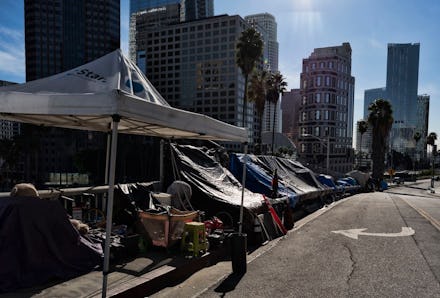Sleeping outside when you have nowhere else to go is not a crime, Supreme Court says

Attempts to crack down on homelessness across many U.S. metropolises are finally being challenged. The Supreme Court declined to hear Martin v. Boise, upholding a lower court's ruling that stated cities cannot punish homeless people for sleeping outside when there are no alternatives. The move is being celebrated by advocates who point out that jail and fines help nobody.
In September 2018, the Ninth U.S. Circuit Court of Appeals established the landmark ruling after hearing a case brought forth by six formerly homeless residents of Boise, Idaho. The court found that punishing people for sleeping outside when there's no other shelter available was a form of "cruel and unusual punishment."
The city's ordinances, which have been around since 1922, aren't unique to Boise alone. For example, a plan under consideration at Los Angeles's City Hall would ban people from sleeping on streets and sidewalks throughout at least 26% of the city. That ban would be in addition to previous rules that made doorways, driveways, and many parks off limits.
In a statement regarding the Supreme Court's decision, Maria Foscarinis, the executive director of the National Law Center on Homelessness and Poverty, said, "Housing, not handcuffs, is what ends homelessness."
The lower court's decision only applies to the Ninth Circuit, which covers nine states. Still, under its jurisdiction are most of the states on the West Coast, which led the NLCHP to note that the court carries "national influence."
It's hard to pinpoint exactly how many people are experiencing homelessness, but the Department of Housing and Urban Development's Annual Point-in-Time Count reported that 552,830 people were experiencing homelessness on a single night in 2018. California has the highest homeless population, at close to 130,000; according to CalMatters, that accounts for 25 percent of the entire nation's homeless population. California has seen a larger increase in homelessness than any other state since 2016.
“Our state has more than 1.7 million low-income households spending more than half their income in housing costs,” said Ben Metcalf, the former director of the California Department of Housing and Community Development. “When you’re paying that much for housing, with so little left over, even a minor shock can start a cycle of homelessness.”
Homelessness continues to be criminalized through other laws. Last week, the NLCHP released a report that showed cities continue to pass "anti-homeless" laws, like banning panhandling or sleeping in cars. Outside of outright bans, cities can erect hostile architecture to target homeless people, like Seattle placing bike racks at a recently cleared encampment. There's also the proliferation of spikes on flat outdoor surfaces or armrests to break up benches.
Communities and organizations have started up campaigns like Housing Not Handcuffs to push back against the criminalization of homelessness. To advocates, addressing the issue through policing is ineffective — and pushes homeless people into a criminal justice system that can do more harm than good.